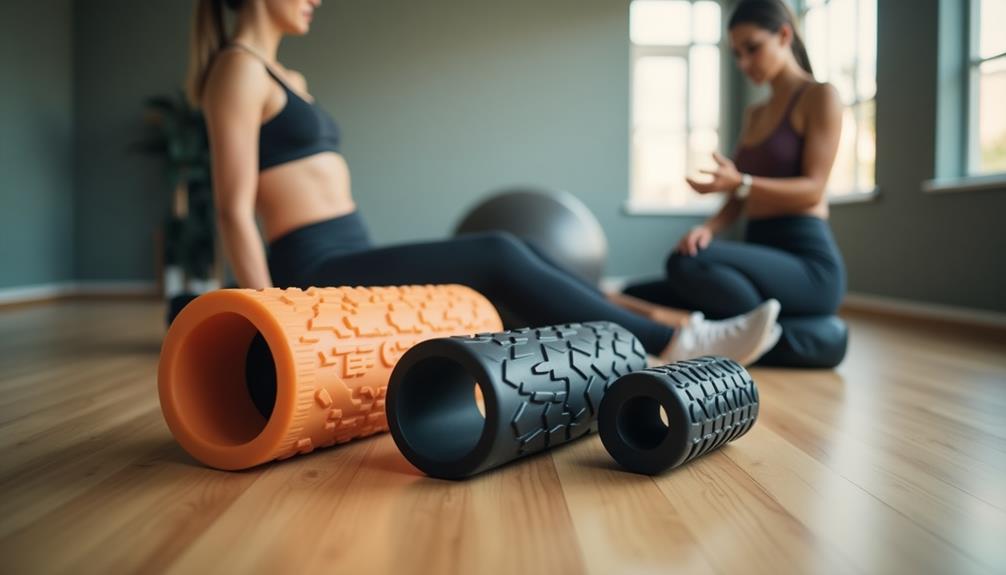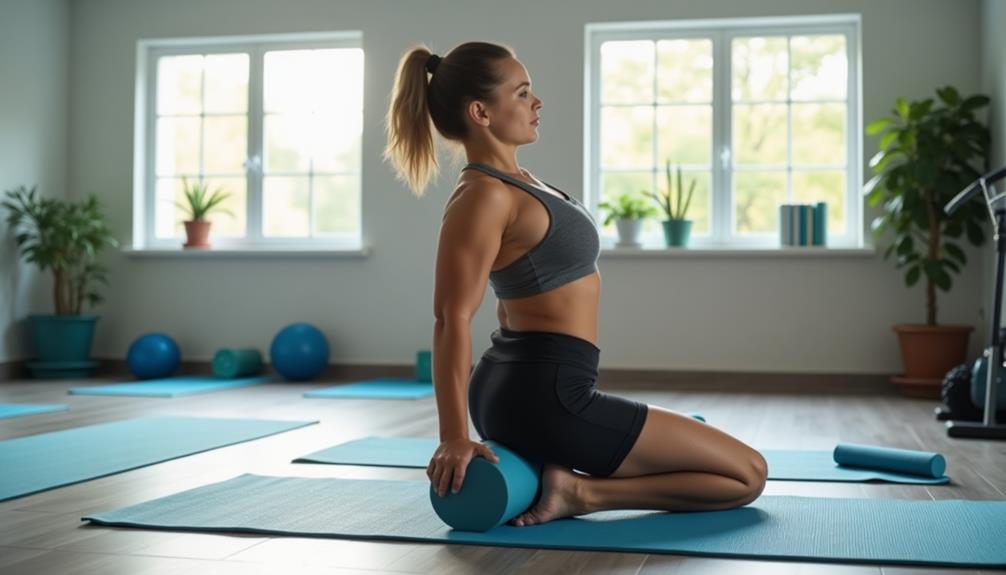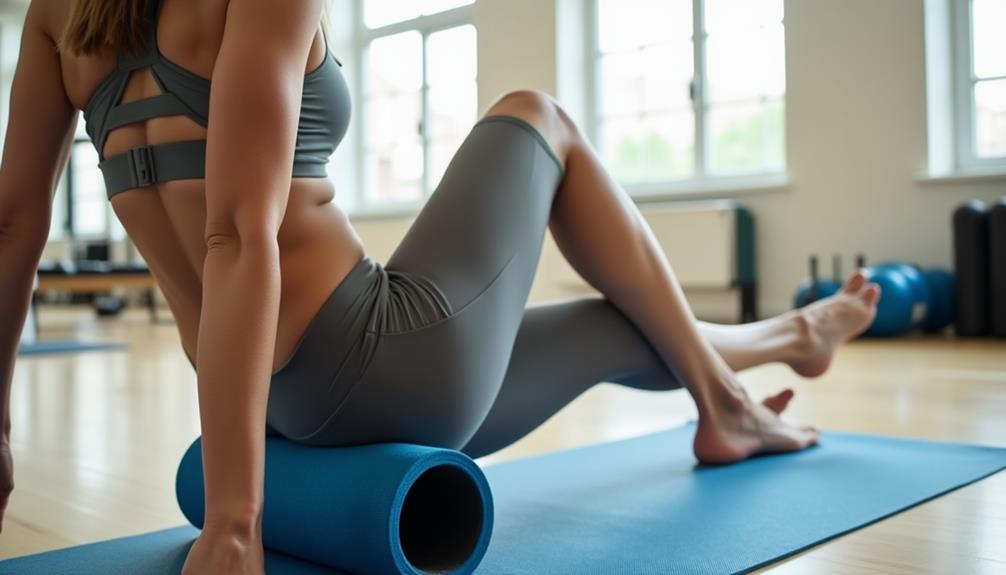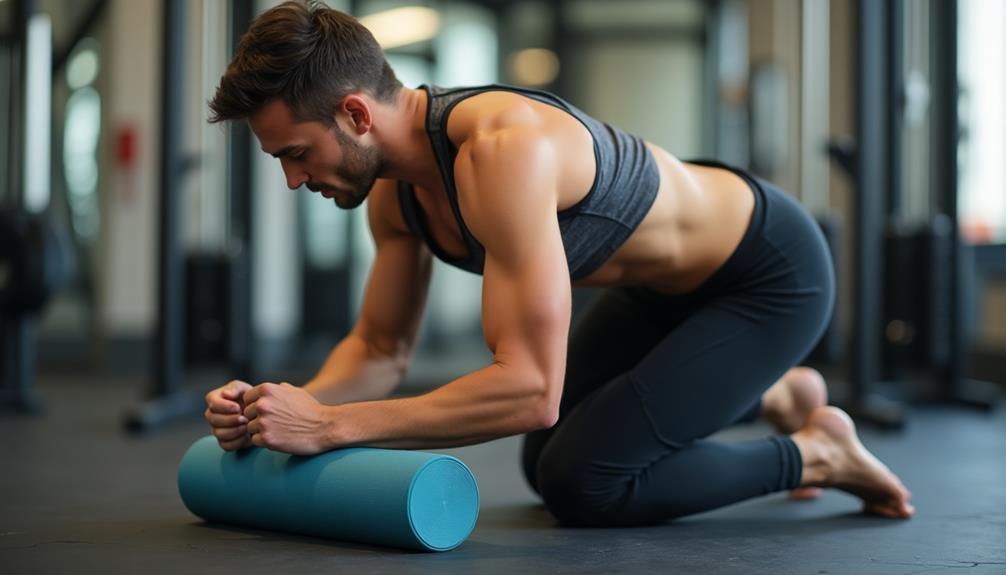Effective foam rolling can greatly decrease soreness after your workouts. Start by selecting the appropriate foam roller based on density and texture, ensuring it fits your comfort level. Next, find a cozy surface to work on. Position the roller under the targeted muscle group, applying your body weight gradually. Roll slowly at about one inch per second and pause on sensitive spots for 20-30 seconds, using deep breaths to ease tension. Aim to foam roll 2-3 times a week, both before and after workouts, for best results. There's more to learn about maximizing your foam rolling technique effectively.
Core Insights
- Foam rolling post-workout helps break down muscle knots and tension, reducing soreness effectively.
- Target key muscle groups like quadriceps, hamstrings, and glutes for optimal relief.
- Roll slowly, applying body weight gradually, and pause on tender spots for 20-30 seconds.
- Incorporate foam rolling 10-15 minutes after workouts to alleviate soreness and aid recovery.
- Listen to your body; if pain is too intense, adjust pressure or stop rolling.
Benefits of Foam Rolling

Foam rolling offers a range of benefits that can enhance your workout recovery and performance. First, it helps reduce muscle soreness by breaking down knots and tension in your muscles. When you roll out tight areas, you improve blood circulation, which can speed up recovery. Additionally, foam rolling increases your flexibility and range of motion. This makes it easier for you to perform exercises effectively and reduces your risk of injury. It's also a great way to relax your muscles after a tough workout. Selecting the ideal foam roller for your needs is essential to maximize these benefits and make sure you're targeting the right muscle groups effectively. By incorporating foam rolling into your routine, you'll notice improvements in your overall athletic performance. Whether you're a novice or a seasoned athlete, foam rolling can be a valuable tool in your fitness journey.
How to Choose a Foam Roller

Selecting the right foam roller is key to maximizing the benefits you've learned about. Start by considering the density. Softer rollers are great for beginners, while firmer options provide deeper muscle relief. Next, think about the size. A standard roller is versatile, but smaller ones are excellent for targeting specific areas, like the back or calves. Many physical therapists recommend high-density foam rollers for their effectiveness in deep tissue massage and myofascial release.
You should also look at texture. Smooth rollers glide easily, while textured ones can enhance muscle relief by providing more pressure points. Finally, consider your personal goals. If you're recovering from an injury, a softer roller might be best. For general soreness, a firmer option could work better. Ultimately, choose a foam roller that suits your needs and comfort level, ensuring you'll use it consistently.
Proper Foam Rolling Techniques

When using a foam roller effectively, it's important to focus on your technique to reap the maximum benefits. Start by choosing a comfortable surface, like a yoga mat or carpeted area. Position the foam roller under the targeted muscle group, then apply your body weight gradually. Roll slowly, using your arms or legs to control the movement. Aim for about 1 inch per second to allow your muscles to relax. When you find a tender spot, pause and hold pressure for 20 to 30 seconds. Remember to breathe deeply, which can help release tension. Consider using a textured surface roller for enhanced blood flow and deeper muscle knot relief. The varied patterns and bumps can provide more targeted pressure, similar to a massage therapist's hands. Finally, keep your movements smooth and avoid rolling over bony areas or joints to prevent discomfort. This mindful approach enhances your recovery and reduces soreness effectively.
Targeting Key Muscle Groups

To maximize the benefits of foam rolling, focus on targeting key muscle groups that often bear the brunt of your workouts. These areas can become tight and sore, making recovery essential.
| Muscle Group | Foam Rolling Tips |
|---|---|
| Quadriceps | Roll slowly, spending extra time on tight spots. |
| Hamstrings | Keep your legs straight and roll from knee to glutes. |
| Glutes | Sit on the foam roller and cross one leg over the other. |
| Calves | Position your calves on the roller and shift weight for pressure. |
| IT Band | Lie on your side and roll from hip to knee, avoiding the bone. |
Frequency and Timing for Foam Rolling

Finding the right frequency and timing for foam rolling can enhance your recovery and performance. Aim to foam roll at least 2-3 times a week, focusing on both pre- and post-workout sessions. Before workouts, spend about 5-10 minutes rolling to warm up your muscles and improve blood flow. This practice prepares your body for exercise and can enhance your range of motion.
After workouts, dedicate another 10-15 minutes to foam rolling. This helps alleviate soreness, reduce muscle tightness, and speed up recovery. Listen to your body; if you're feeling particularly sore, consider adding an extra session. Ultimately, consistency is key, so find a routine that works for you and stick to it for the best results.
Common Mistakes to Avoid

Foam rolling can be a game-changer for your recovery, but many people make common mistakes that limit its effectiveness.
Not Enough Pressure
One mistake is not applying enough pressure. You won't get the benefits if you're just lightly rolling.
Rolling Too Fast
Another common error is rolling too quickly. Take your time to let the foam roller work on your muscles.
Ignoring Pain Signals
Don't ignore pain signals. If you feel sharp pain, you may be rolling on an injury.
Neglecting Specific Areas
Lastly, avoid neglecting specific areas. Focus on tight spots and spend extra time there, but know when to stop if it hurts too much.
Frequently Asked Questions
Can Foam Rolling Help With Injury Recovery?
Foam rolling can aid in injury recovery by increasing blood flow and reducing muscle tension. When you incorporate it into your routine, you'll likely experience improved flexibility and quicker healing, helping you get back to your activities sooner.
Is Foam Rolling Suitable for All Fitness Levels?
Absolutely, foam rolling's like having a personal massage therapist at home! It's suitable for all fitness levels; anyone can benefit. Just start slow, listen to your body, and roll your way to better recovery.
How Long Should I Foam Roll Each Session?
You should foam roll for about 10 to 15 minutes each session. Focus on areas that need extra attention, ensuring you maintain a steady pressure to maximize the benefits and promote muscle recovery effectively.
Can Foam Rolling Replace Stretching?
While foam rolling offers benefits, it can't fully replace stretching. Think of it like the sun and moon; both have unique roles. You need both to maintain flexibility, mobility, and overall muscle health in your routine.
Are There Any Contraindications for Foam Rolling?
Yes, there are contraindications for foam rolling. If you have certain medical conditions like fractures, deep vein thrombosis, or severe varicose veins, you shouldn't use a foam roller. Always consult a healthcare professional first.

